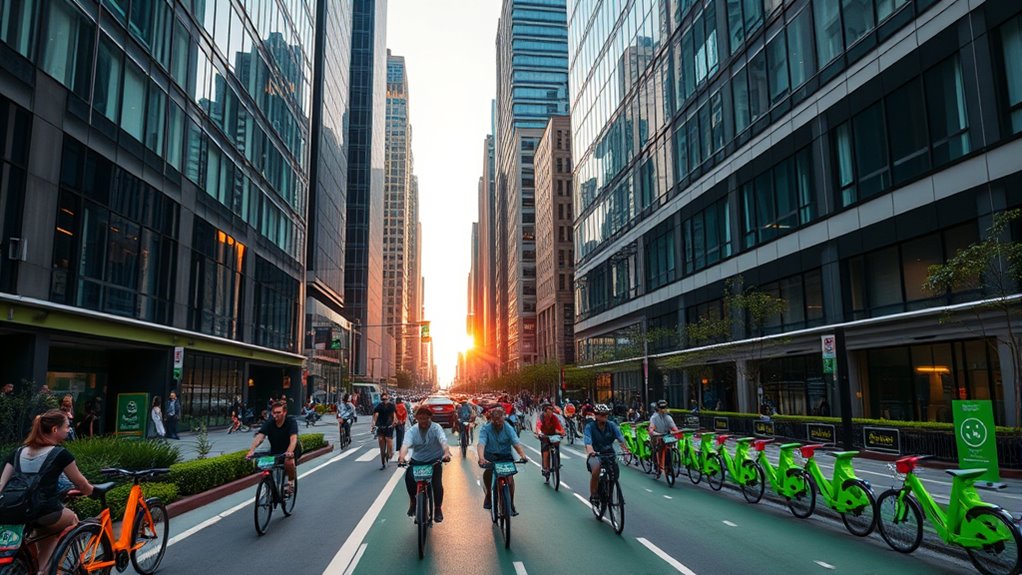Urban cycling is transforming city planning by driving the development of protected bike lanes, smarter infrastructure, and integrated mobility options. Expect cities to prioritize safety, sustainability, and accessibility through innovative designs, incentives, and eco-friendly materials. This shift boosts local economies, reduces pollution, and promotes healthier lifestyles. As cycling becomes central to urban life, understanding these changes will help you see how cities evolve to become more sustainable and inclusive—exploring these shifts further reveals exciting future trends.
Key Takeaways
- Urban cycling growth prompts cities to expand protected bike lanes and infrastructure for safety and accessibility.
- Integration of cycling with public transit encourages multimodal mobility and reduces urban congestion.
- City planning increasingly prioritizes sustainable materials and smart technologies to support durable, eco-friendly bike infrastructure.
- Cycling’s environmental and health benefits drive policies that promote active transportation and urban sustainability.
- Challenges include ensuring safety, infrastructure maintenance, and widespread adoption, shaping future inclusive city designs.
Growing Global Bicycle Markets and Trends
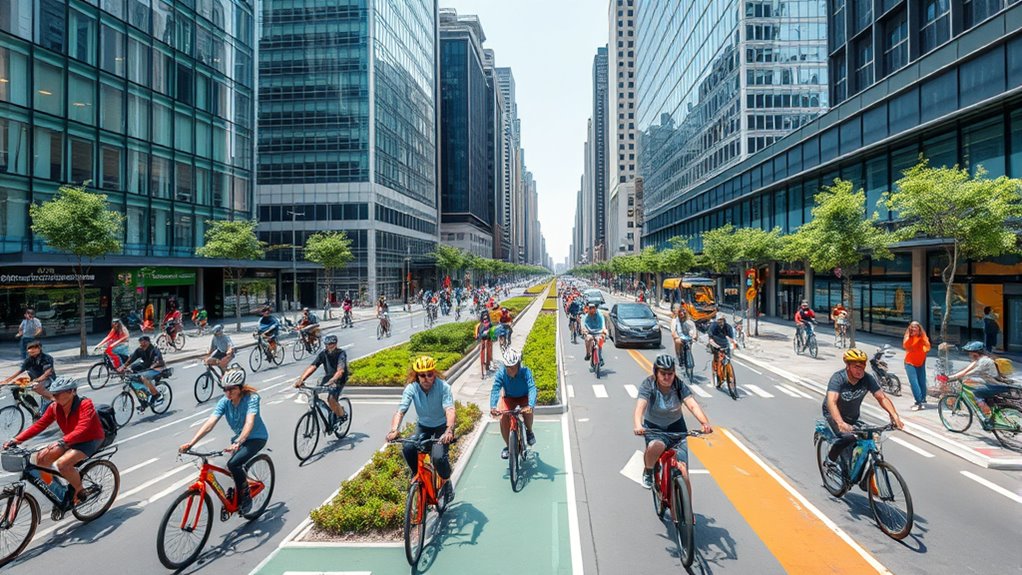
The global bicycle market is experiencing rapid growth, driven by increasing urbanization, health awareness, and environmental concerns. You see the market valued at around $66.1 billion in 2024, with projections reaching $135.02 billion by 2030, growing at nearly 10% annually.
The bicycle market is booming, fueled by urban growth, health, and eco-consciousness, with rapid annual expansion projected through 2030.
The premium bike segment is also expanding, expected to hit $12.3 billion by 2025 and continue growing at 7.3% annually through 2035.
Asia-Pacific dominates this market with a 34.4% share, thanks to countries like China, Japan, and Singapore, while Europe emerges as a key area for expansion, especially for bike-share operators.
E-bikes are a major growth driver, with features like GPS connectivity and lightweight materials attracting urban commuters and developing nations alike. The role of technology in enhancing e-bike features is expected to further accelerate this growth trajectory.
Furthermore, the integration of smart features such as app connectivity and advanced sensors is transforming e-bikes into more versatile and user-friendly transportation options, fueling their adoption in cities worldwide. Additionally, innovations in battery technology are extending e-bike range and reliability, making them even more appealing for daily urban use. To combat potential fraud risks associated with e-bike transactions and leasing, businesses are increasingly adopting fraud detection tools to ensure secure payments and protect consumers.
Recent advancements in digital security also contribute to safeguarding online transactions and building consumer trust in the expanding e-bike market.
Infrastructure Innovations and Policy Shifts

Innovative infrastructure and forward-looking policies are transforming urban cycling landscapes worldwide. Underground parking solutions like Tokyo’s Eco Cycle system and Amsterdam’s Open Havenfront offer space-efficient, weather-resistant storage, reducing theft and maintenance costs while supporting dense city centers. Resources and tools such as detailed planning guidelines and community engagement strategies play a crucial role in successful implementation. Solar-powered paths, such as Seoul’s solar bike lane, generate clean energy, while smart traffic lights and LED-illuminated lanes improve safety and flow, especially at night. Policy initiatives like the BICI program and public-private partnerships boost cycling infrastructure, secure bike-to-transit access, and promote safety through protected bike lanes and bike boxes. Adaptive street redesigns, including protected intersections and grade-separated pathways, increase rider safety and comfort. Incorporating AI security solutions into urban infrastructure can help monitor and maintain these systems more effectively, ensuring safety and reliability. Integrating predictive maintenance strategies can further optimize infrastructure performance and reduce downtime. Community engagement and education efforts further enhance infrastructure effectiveness, ensuring cycling becomes a seamless, integrated part of urban mobility. Incorporating drivetrain components that are durable and easy to maintain can also extend the lifespan of bikes used in city environments, reducing costs and encouraging more residents to choose cycling. Additionally, the integration of cookie management solutions helps cities gather data on cycling usage patterns while respecting user privacy, supporting continuous infrastructure improvements.
Economic Benefits and Market Dynamics
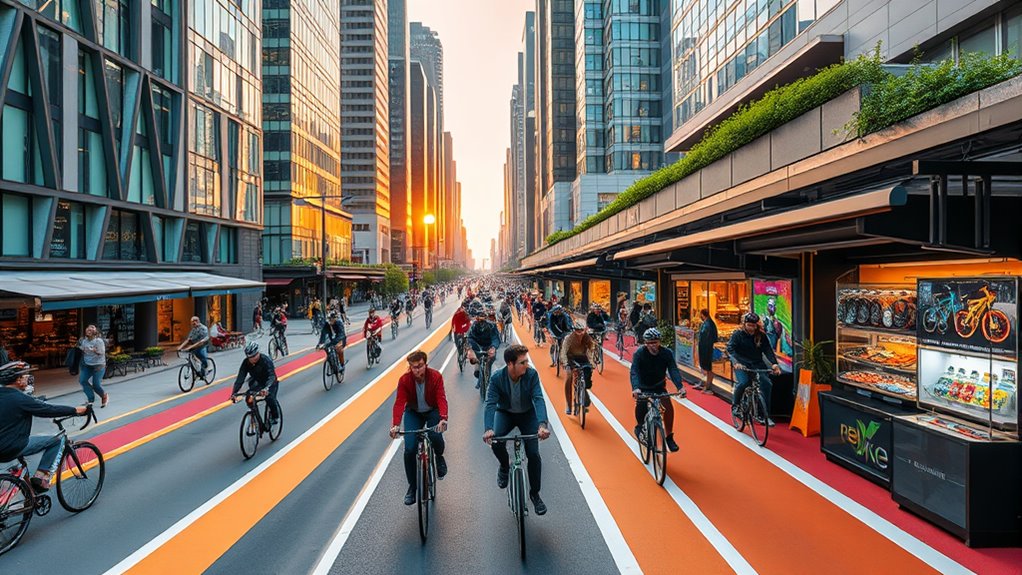
Urban cycling delivers significant economic advantages for individuals and communities alike. You save money on transportation costs by avoiding car ownership, fuel, parking, insurance, and maintenance. Cyclists tend to spend 40% more monthly at local businesses, boosting neighborhood economies.
Regular cycling improves your health, lowering healthcare expenses and reducing the economic burden of inactivity and traffic crashes. For cities, infrastructure costs for bike lanes are a fraction—about $250,000 per mile—compared to $60 million for freeways, saving taxpayer money.
Reduced congestion and pollution lower costs related to road maintenance, emissions, and health. Cycling projects generate 30% more jobs than road-only initiatives, fostering industry growth, tourism, and retail.
This vibrant activity revitalizes neighborhoods, increases property values, and enhances regional economic resilience.
Environmental and Public Health Advancements
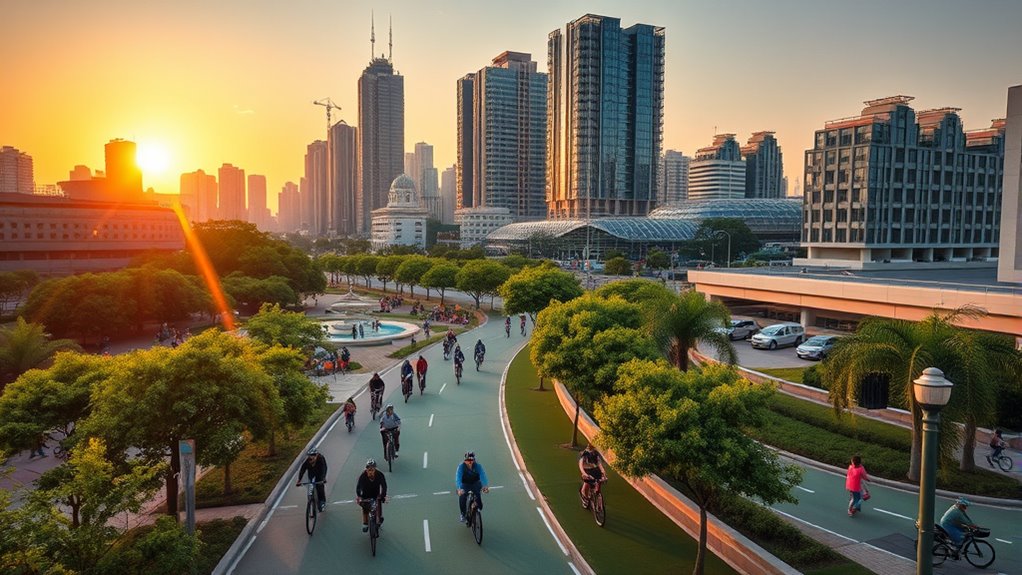
Have you ever considered how cycling directly benefits the environment and public health? Every ride helps cut CO2 emissions—cycling just 7 km saves about 1 kilogram of CO2, and switching one trip daily can reduce your annual carbon footprint by half a tonne.
Bicycles emit zero pollutants, improving urban air quality, especially during peak hours when congestion worsens pollution levels. Increased cycling also promotes better public health by encouraging physical activity, reducing obesity, and lowering the risk of chronic diseases. This means fewer healthcare costs and longer lives.
Cities are supporting this shift by building bike lanes, integrating cycling into transit, and creating green spaces. These advancements foster cleaner, healthier urban environments and promote sustainable living for everyone.
Addressing Equity and Accessibility Challenges

Addressing equity and accessibility challenges is essential to creating a truly inclusive cycling environment. Without adequate infrastructure, marginalized groups face barriers like unsafe routes and limited protected bike lanes.
Personal security concerns, especially for people with disabilities or vulnerable populations, can discourage cycling altogether. Cost remains a significant obstacle—expensive equipment and lack of affordable storage limit participation.
Educational gaps further widen inequities, as lower-educated populations tend to cycle less. Implementing universal design standards and community engagement helps ensure infrastructure meets diverse needs.
Providing affordable storage, promoting bike-sharing programs, and creating policies that reduce vehicle speeds foster safer, more accessible environments. Targeted resources and outreach ensure lower-income communities can access and benefit from urban cycling, making the movement truly inclusive for everyone.
Projected Developments in Urban Cycling
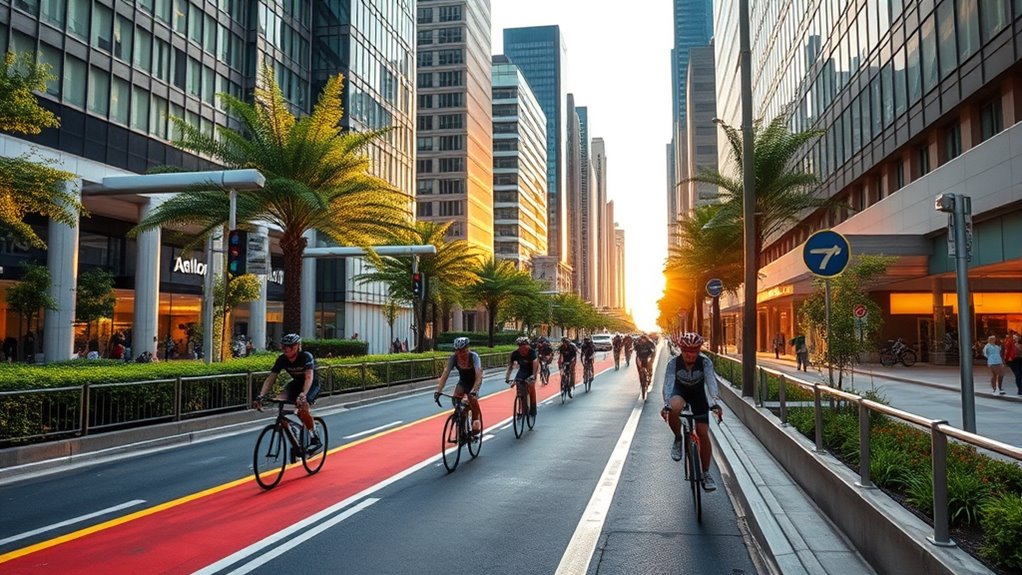
What’re the key trends shaping the future of urban cycling? You’ll see innovative commuting methods like bike buses and school streets gaining popularity, emphasizing safety and community.
E-bike adoption is accelerating, expected to grow over 8% by 2025, making urban mobility easier.
Cargo bikes are becoming common for freight, promoting sustainable logistics.
Federal support is fueling infrastructure improvements, including protected bike lanes and charging stations for e-bikes.
Cities are implementing smart bike systems and integrating cycling into app-based mobility platforms.
Advancements in e-bike technology, longer battery life, and safety features like collision detection are transforming rider experience.
These developments aim to reduce emissions, ease traffic congestion, and promote healthier, more inclusive urban environments, shaping a future where cycling plays a central role in city life.
Implications for Future City Planning Strategies
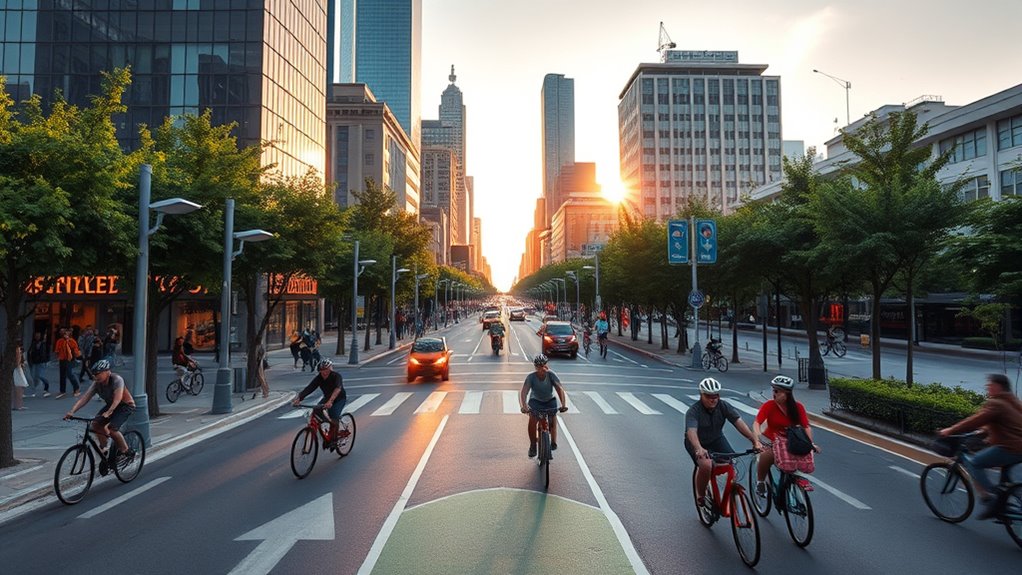
As urban cycling continues to grow with innovations like e-bikes and cargo bikes, city planners must rethink infrastructure development and integration. You should prioritize safety measures that protect cyclists and pedestrians, encouraging more people to choose cycling.
Expanding bike lanes and cycle paths is essential for creating an appealing, accessible network. Integrating cycling infrastructure with public transport enhances overall mobility and convenience.
Using sustainable materials supports environmental goals, while regular maintenance guarantees infrastructure safety and durability.
Policy strategies like participatory planning and community feedback help tailor solutions to local needs. Offering incentives such as bike parking and ensuring seamless intermodal connections boost cycling adoption.
Frequently Asked Questions
How Do Cities Balance Bike Infrastructure With Other Transportation Needs?
You can balance bike infrastructure with other transportation needs by integrating cycling with public transit and mixed-use development. Prioritize data-driven decisions to identify where bike lanes are most needed, and involve the community for support.
Install protected lanes and optimize traffic signals to guarantee safety. Regular maintenance and safety campaigns help, while promoting cycling reduces congestion, pollution, and noise—making the entire transportation system more efficient and sustainable for everyone.
What Funding Models Support Equitable Bikeshare Expansion?
Imagine a city where every street breathes with movement, and everyone has access to bikes. Funding models like public-private partnerships, community-based initiatives, and municipal grants make this feasible.
You benefit from corporate sponsorships, local business investments, and government bonds that prioritize equity. These diverse strategies ensure bikeshare services grow fairly, reaching underserved neighborhoods and creating an inclusive, vibrant urban landscape for all residents to enjoy.
How Will Autonomous Vehicles Influence Future Cycling Infrastructure?
You’ll see autonomous vehicles influence future cycling infrastructure by prompting city planners to redesign roads for safety and efficiency. AVs’ improved detection and predictability can foster better protection for cyclists.
Infrastructure upgrades like clearer lane markings and communication systems will support both AVs and cycling. Cities might also develop new regulations to guarantee safe interactions, making cycling safer and more appealing, encouraging more people to choose active transportation options.
What Strategies Improve Safety for Marginalized Cycling Communities?
Think of inclusive safety strategies as the backbone of equitable cycling. You should focus on installing protected bike lanes that shield marginalized users, making facilities accessible with ramps and lifts, and engaging communities directly in planning.
Low-cost tweaks, universal design, and reduced vehicle speeds create safe, welcoming environments. By prioritizing safety and listening to local voices, you guarantee everyone can ride with confidence, no matter their background or ability.
How Can Urban Planners Integrate Cycling With Public Transit Effectively?
To effectively integrate cycling with public transit, you should prioritize designing bike lanes and paths near transit stops for easy access.
Install secure bike parking and implement bike-sharing systems to boost flexibility.
Use clear signage to guide cyclists and collaborate with transit agencies for seamless connections.
Regularly assess and adjust your infrastructure based on user feedback and data, ensuring the system remains efficient, safe, and encourages more people to cycle and use transit.
Conclusion
As urban cycling continues to surge, imagine a city where over 50% of commuters choose bikes daily, reducing traffic congestion and pollution. This shift isn’t just a trend; it’s a movement transforming city planning and public health. Embracing these changes now means designing smarter, more accessible spaces that prioritize cyclists and pedestrians. By harnessing this momentum, you can help create vibrant, sustainable cities where everyone benefits from cleaner air and healthier lives.
